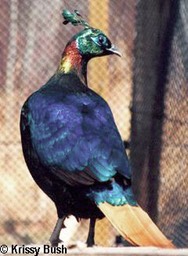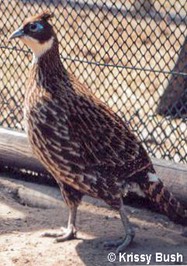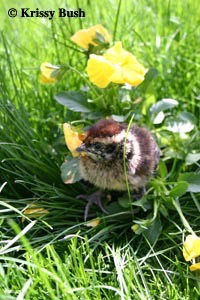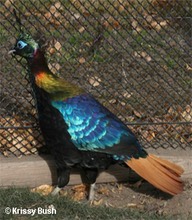Scientific Information
Class: Aves
Order: Galliformes
Family: Phasianidae
Subfamily: Phasianinae
Genus: Lophophorus
Species: Lophophorus impeyanus
Species English name: Impeyan Pheasant/Himalayan Monal
CITES Status: CITIES I - endangered
Distribution: Himalayas - from Afghanistan to Bhutan
(from A Monograph of Pheasants Volumes I & II, William Beebe)
Description
• Male - large & stocky with assorted coloured metallic feathers and a black front. Long erect metallic teardrop crest.
• Female - Shades of brown and cream with well defined feather pattern.
• Extremely hardy birds. They love snow and inclement weather.
Diet
• We feed our breeders and young adults 16% layer pellets, our tiny chicks 25% Turkey Starter crumble, and our growing chicks 20% crumble.
• Impeyans are big treat lovers. They get a handful of mixed grains every second day except during breeding season, fresh greens (lettuce, chickweed, dandelions, grass) and fruits (tomato, grapes, berries, etc.) when available.
Breeding
• Done in pairs. Impeyans are very monogamous birds and become very attached to their mate. Trios are not recommended because the dominant female will usually try to kill the less dominant female.
• Impeyans are second year birds meaning that the female will not lay eggs and the male is not fertile until their second year. We have had females lay a few eggs in their first year though.
• They start laying eggs around the end of the first week of April and will lay every second day until they lay approximately 12-20 eggs.
• They lay very large splotchy eggs.
Incubation
• Eggs are collected twice a day and marked with the date and breeding pen number and set daily.
• Eggs are set in an automatic turning Lyons Roll-X (RX2) with grid 71
• Temperature 99.8°F, humididty-wet bulb 80 with humidity adjusted periodically depending on development of the air space shown by candling
• On the final day of incubation, each egg is placed in its own oval wire mesh hatching basket (6" x 3" x 3") and set in the Sportsman Rattite hatcher.
• Incubation for Impeyans is 27-28 days.
• After the chick hatches, it stays in the hatcher for a minimum of 8 hours.
Chicks
• When the chicks come out of the incubator they are the pudgiest and one of the cutest chicks you will ever see. They look like tiny brown and black striped sumo wrestlers with stocky stubby legs.
• They start out in our round 18" brooder pen with a mixed assortment of chicks. After a few days they are separated into a 2' x 4' baby pen for about a week. They are then transferred to an all Impeyan 2' x 6' pen for the next 7-9 weeks. They stay with this grouping until they are sold. All of these brooding pens have wire bottoms with a heat lamp at one end and feed & water at the other end. The heat lamp is attached to a dimmer switch so we can turn down the amount of heat as the chicks get older until it is turned off completely.
• After they are off of the heat for a few weeks, they are moved outside to the pheasant house (has outside grassy pens and a heated inside house part where they are blocked in for the night). After they are toughened up, they are moved to an outside chick pen.
• Chicks are very easy to raise together with their own kind. You can mix quite a variety of ages and sexes without problems.
Pens
• 25' long x 10' wide x 6' high with a 4' x 4' x 4' house in the middle.
• Pens are covered with 2" diamond top-rite.
• 1 Impeyan Hut (1' x 1' x 2' high) containing straw in the corner for laying eggs.
• Pens contain grass, but since Impeyans are rooters, need to move to another pen every 1-3 years to let the grass come back.
• See Scintillating Copper Article for predator proofing set-up
Behavior
• Are calm and relatively quiet birds. Impeyans do make a high pitched scream/shriek when they feel threatened and a hiss/heavy breathing noise during their breeding display. This breeding display consists of the the male tilting as far forward as possible without falling on his head with his wings spread and his cheek feathers slanted forward to cover part of his eyes and beak. He moves his neck in a snake-like manner while bouncing forward on both legs with his tail flung up in the air. Young males particularly like to practice this when they have an audience. The odd female has been known to do this display as well.
• They are very easy to tame down and are incredibly friendly and curious birds.
• The males can become aggressive enough to attack humans during breeding season.
Article By Krissy & Donna Bush
Pheasant Ridge



